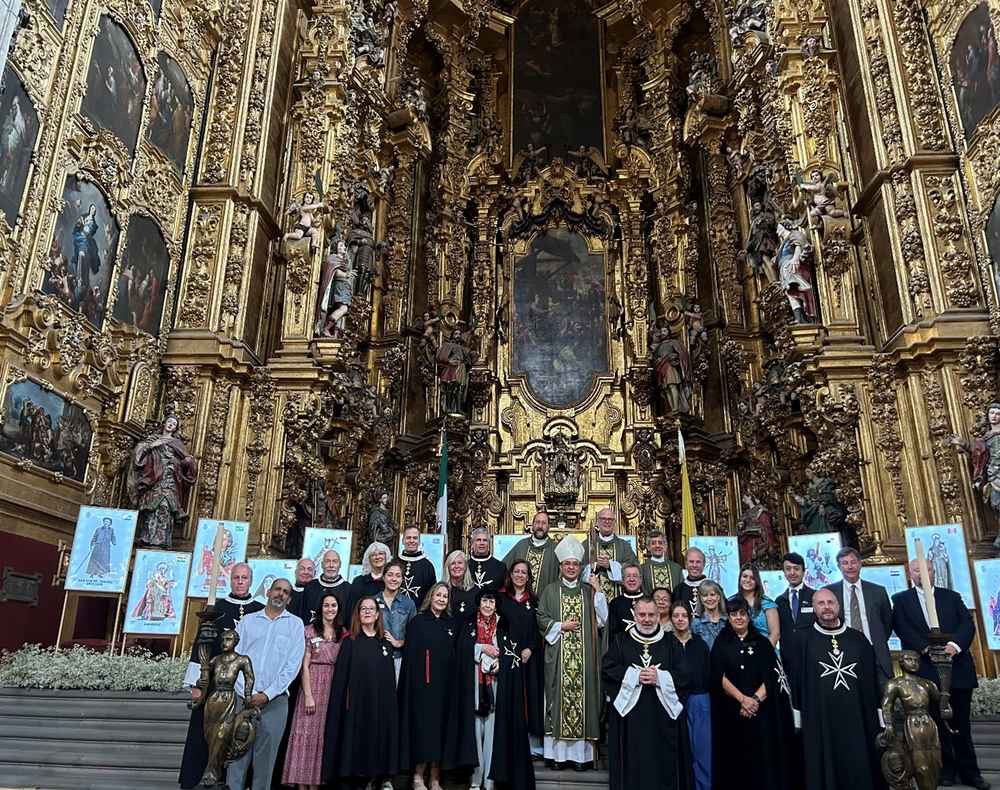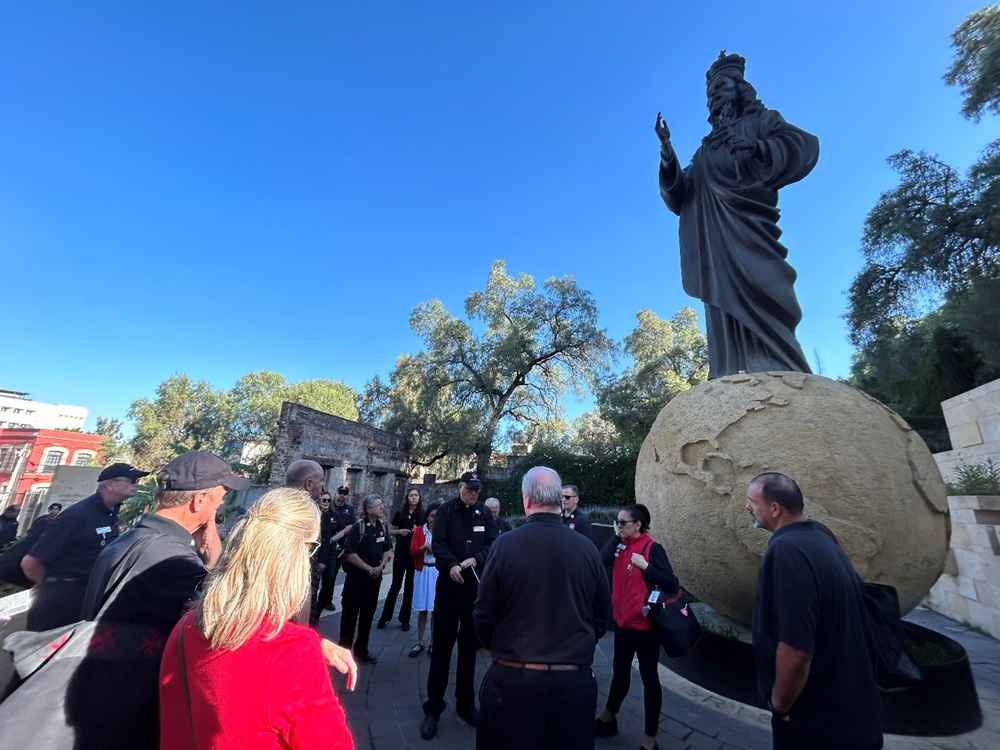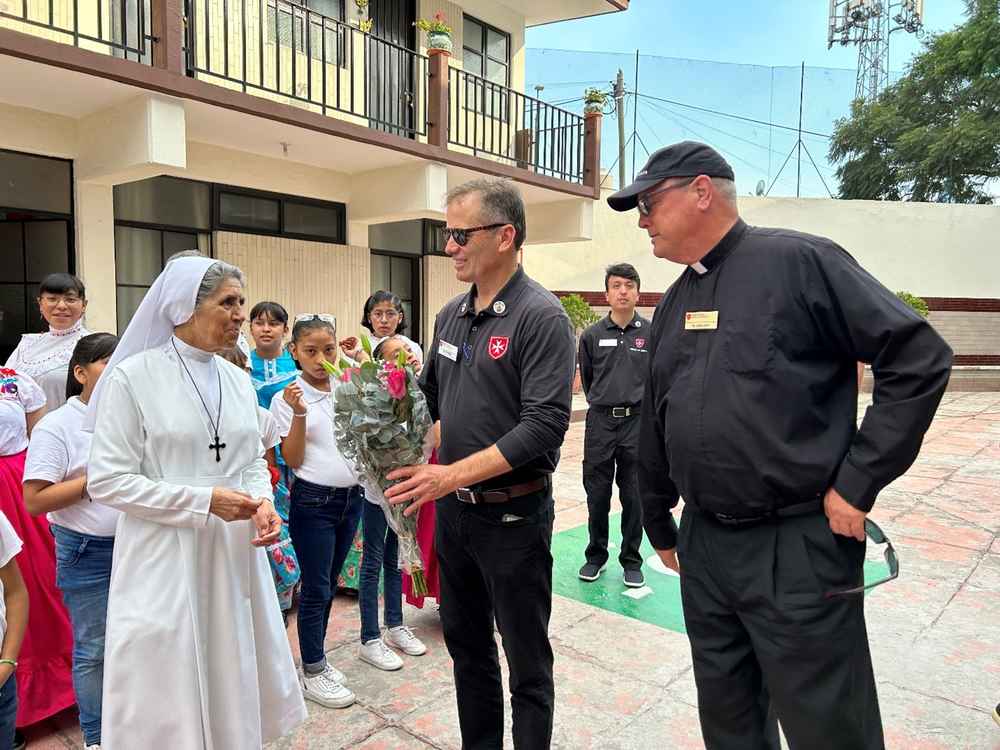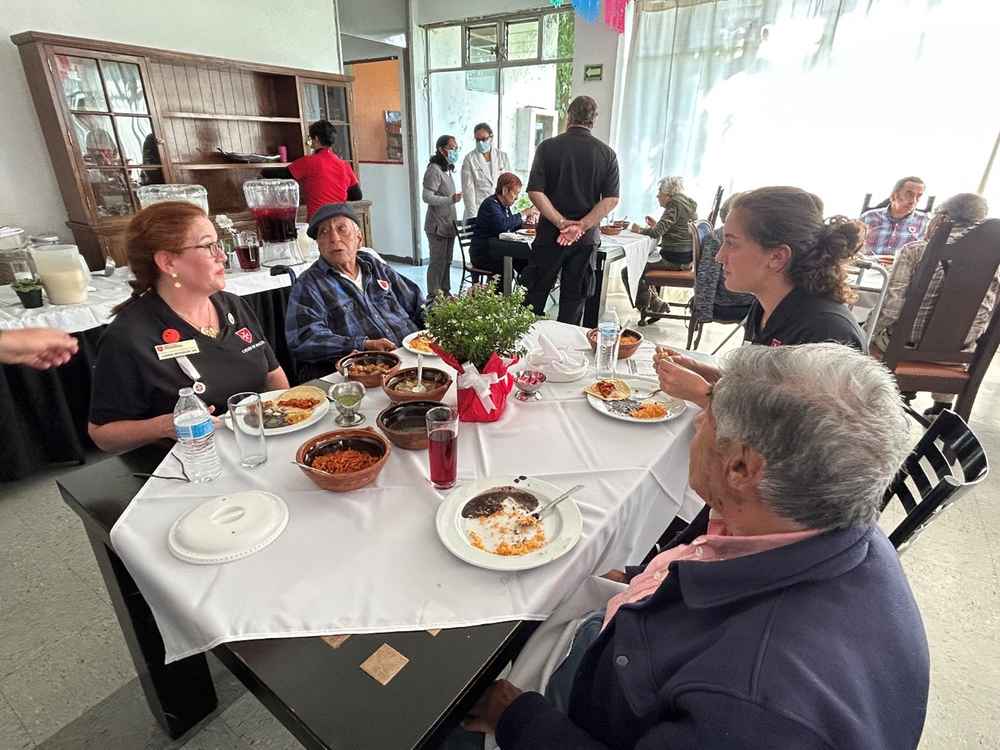Ascending Tepeyac: Pilgrimage of Faith and Works

Malta pilgrims with bishop after Mass at Metropolitan Cathedral of the Assumption of the Blessed Virgin Mary into Heaven

Pilgrims gather at the statue of Christ the King, halfway up Tepeyac

Pilgrimage leader Duke Powers, KM, of the Western Association, with Father John Love, presents the superior with a bouquet after lunch at Nuestra Señora de la Paz school and orphanage

Andrea Wilkinson, DM, of the Federal Association and her niece Katherine Wilkinson enjoy breakfast with residents of the Casa Hogar San Juan residence for the elderly
At the Basilica of Our Lady of Guadalupe in Mexico City, built on the plain stretching from the foot of Tepeyac, the great hill where in 1531 the Blessed Virgin appeared to an Indian convert, followed by widespread conversion of indigenous peoples of Mexico and Central America, a woman inched forward on her knees from the back pews to just short of the altar rail, bearing a thick bouquet of roses wrapped in green fronds. Perhaps in desperate petition, perhaps in joyful thanksgiving, her expression remained fixed in devotion.
It was the Mass for the World Day of the Sick, October 14, 2023, organized by the Order of Malta Mexico Association and joined by a Western Association-sponsored pilgrimage that included members of the Federal and American associations. Each year the Mexico Association promotes this Mass among parishes throughout a metro area of 22 million, particularly to those whose parishioners might lack the physical or financial wherewithal to come on their own. The Mexico Association provides several buses to transport them and recruits youth groups—as well as pilgrims on the Western Association pilgrimage—to meet them with wheelchairs and other assistance as necessary.
Our cohort of knights, dames, candidates, volunteers, and a chaplain had arrived three days earlier for a pilgrimage of prayer and service, traveling by private bus weaving through and around knots of traffic in a city rising from what was once a lake bed, a bowl formed by surrounding mountains. The trips veered between extremes of a boulevard lined with richly appointed apartment buildings and lush foliage intertwining in a canopy overhead, to a drab highway running through an extended marketplace of second-hand clothes and toys under corrugated metal roofs and, on a curb, a seated woman cradling a large child, apparently asleep. Contrasts perhaps no more extreme than those appearing in any American metropolis, just more vivid to the transiting pilgrim.
The pilgrimage began on an elemental note as Dr. John Sheridan, a neurosurgeon from Palo Alto, California, stood at the front of the bus to warn of gastro-intestinal sensitivities to differences in water filtration and food preparation here. The experience shifted to a more ethereal tone as we entered the basilica grounds for a meandering hike, interrupted by lessons in faith and history provided by some of our hosts in the Mexico Association, to the top of Tepeyac.
It was here that the Blessed Virgin appeared to a man born as Cuauhtlatoatzin (the “talking eagle”) of the Chichmeca people, who took the name Juan Diego at his baptism as a young man under early Spanish evangelization. He was walking from his village nine miles away to attend Mass when, heralded by birdsong, a woman in a bright white cloud surrounded by a rainbow intercepted him at Tepeyac, identifying herself as “the Mother of the true God.” Addressing him in his native Nahualtl language, she asked him to carry a message to the archbishop, a Spanish Franciscan, that she desired a sacred building to be built at Tepeyac in her honor. Though Juan Diego hastened to deliver the message on two separate occasions, the archbishop did not believe him but, seeing something in his persistence, asked for a sign. In a subsequent apparition, near the bottom of Tepeyac, the Lady instructed Juan Diego to summit the hill and pick roses—Castilian roses that would never have bloomed at that time of year. This Juan Diego did, gathering them in his tilma, a coarse cloak made from cactus fibers. Returning to the episcopal palace, Juan Diego opened his tilma to let the roses fall, and on his tilma was the image of the Blessed Virgin as she had appeared to him.
Over the next half millennium, some six sanctuaries were built in response to the Virgin’s directive, including one basilica, completed in 1709 that has since tilted forward on its former lakebed foundation, resulting in a distinct uphill walk from the entrance to the altar. Around a corner of the plaza sits the current basilica, of more modern design, completed in 1976. There, in a great room behind the altar, the tilma is displayed, its otherwise highly degradable fabric and colors essentially undiminished by the centuries. Visitors view it at some distance beneath, from three parallel conveyor belts rolling them past it.
Before seeing the tilma ourselves, we pilgrims wound our way toward the summit of Tepeyac, stopping at a paved clearing in the wild foliage, dominated by a statue of Christ the King holding a scepter and standing on a globe, his orb. The monument was erected in memory of the martyrs and other victims of the Cristero War of 1926-1929 when Catholics took up arms against the revolutionary government’s suppression of the faith in Mexico. The rallying cry, and the last words of priests and others brought before firing squads, was “Viva Cristo Rey” (“Long Live Christ the King”), proclaiming Christ, not the government, as their sovereign. Placing this lesson immediately before us, Paul Navarro, an auxiliary member from Orange County, California, recalled that his grandmother, a young woman in Mexico during the Cristero War, protested laws forbidding public display of Christian imagery. Prohibited from wearing a cross on her clothes, she had one tattooed underneath them, on her chest. Much later, as a grandmother, she would chide those of her grandsons who had themselves tattooed for what she deemed lesser causes.
From the Tepeyac summit we descended to the plaza stretching before the current basilica for Mass, which on this day was celebrated in honor of the coronation of the Virgin of Guadalupe. Men and women in noble indigenous dress handed out roses to all in attendance.
Afterward, the pilgrimage entered its service phase with a visit to Nuestra Señora de la Paz, a school and orphanage for girls run by the Servants of the Sacred Heart of Jesus and the Poor. After a tour of the classrooms and sleeping quarters. we sat down to a simple lunch with some 25 girls, ages 9 to 14. Several of the pilgrims spoke Spanish, to varying degrees, facilitating conversation. At one table, a girl introducing herself as coming from Oaxaca, age 9, said she had been brought here just weeks ago by an aunt. Her parents had split up, formed new attachments that afforded little room for children produced by previous marriage. Asked what she liked best of her new surroundings, the girl pointed to the sisters—all in black habits with white collars and cornettes except the superior whose habit was gray. The girls dressed in uniforms of blue jeans and white polo shirts, though not completely uniform—each of different make and design.
The visit culminated in an exchange of gifts. The girls bestowed on us a spirited performance of folkloric dances on a sunny patio as we watched from the shade. Our response, after much applause, was to distribute gift bags containing various-colored rosaries, stickers, pens, magic markers, and erasers, which the girls eagerly displayed to each other for comparison. We departed to more songs, of joy and thanksgiving.
The work of service continued the next day with breakfast, lunch, and Mass with the people of Casa Hogar San Juan, a residence for the elderly owned and operated by the Order of Malta in Mexico. Again, our work was one of companionship, and in some cases, assisting in the feeding of residents unable to do it themselves. Somehow, the pilgrims were seeded among the residents with whom they best belonged, regardless of Spanish fluency, or lack of it.
Thus, Domenico Complisson, a candidate from San Diego who spoke no Spanish, somehow ended up seated with a resident of German heritage and fluent in a second language he did speak—German. Thus, at a table nearby, a woman conversed in English with two pilgrims whose Spanish was only halting, about how she learned English when young to prepare for a career with Catholic Relief Services. Coming to the part of her life’s review about why she never married, her English rose to lyrical level in describing the proposals she turned down from five different men.
The spurned proposals afforded apt thematic transition as we proceeded to an adjoining porch for mariachi songs of unrequited love. A troupe of professional dancers accompanied the music with zapateado, a rhythmic tapping of hard shoes against a harder floor, as they lifted and twirled the hems of skirts ablaze with pastel stripes against solid backgrounds. The music was recorded but the percussion, pierced by cathartic yells, was abundantly live.
We and our new friends from lunch proceeded to Mass in a large gazebo in the backyard, celebrated by our chaplain for the trip, the Rev. John Love, pastor of Santa Clara Church in Oxnard, California. He ministered throughout the pilgrimage, in diverse and makeshift circumstances: leading us in recitation of the rosary above the din of air conditioning on the bus; celebrating Mass and delivering a homily, in which he shifted seamlessly between English and Spanish, deploying just enough of each to keep both cultures fully engaged; and hearing confessions in improvised settings—whether in a quiet corner of a bustling hotel lobby or leaning against a centuries-old adobe wall of a cathedral anteroom.
After Mass, the visit concluded with a talk by Ana Rita Valero de García Lascurain, a dame of the Mexico Association and an anthropologist and leading authority on Guadalupe and its historical impact. She talked about how the apparition in 1531 established a bridge between the Spanish and indigenous peoples, forming them in a Mexican identity. Or, as she put it in her book, “Santa Maria de Guadalupe: In the Light of History,” which she handed out to us in English translation: The face of the Virgin is dark, with long straight black hair, “eminently Mexican,” yet possessing certain European features “seen as the fusion of two ethnic groups that are in the basin of Mexico in the 16th century. That is why we think of the face of the Virgin as in the reflection of the true face of Mexico.”
The next day we experienced the midday meal we call lunch as the more elaborate mid-afternoon affair that it is in Mexico, being particularly lavish for the gathering of U.S. and Mexican associations of the Order of Malta on the patio of a Spanish colonial-style restaurant. The tables were already stocked with hors d’oeuvres of crickets, breaded and lightly fried. Following on were chips to dip in guacamole and salsa, leading to more substantial fare of duck patties and crab meat, segueing into soup, and crowned with a main course choice of beef and fish, and concluding with dessert choices of custard and chocolate. Waiters swung by with repeated offers of tequila, wine, beer to wash it all down. After all, Americans were not supposed to drink the water here.
In relief, the evening meals were later and lighter.
Fittingly, the gospel reading the next day at the Metropolitan Cathedral of the Assumption of the Blessed Virgin Mary Into Heaven, was about a king issuing a general invitation to his banquet, with few accepting it. The archdiocesan cathedral, built in parts between 1573 and 1813, was a feast—of gothic, neo-classical, baroque architectural style and piety—from which one could hardly turn away. Reredoses in shimmering goldleaf towered behind the main and side altars, embedded with religious paintings, overlooking carved, colored biblical and sainted figures, many bearing miraculous heritage. Just one example: a life-sized crucifix standing by a side altar, with Jesus all black. Tradition has it the image got that way by a miracle protecting a priest from mortal danger.
According to the account, a man confided in the sacrament of Confession that he planned to commit a crime. Not understanding, or not believing in, the seal of Confession, he sought to kill the priest-confessor as a potential witness. Knowing that the priest kissed the feet of the crucified Christ upon entering the cathedral each day, he slathered the feet with poison. When next the priest came to kiss the feet, the statute moved its legs away from the priest and, taking the poison into itself, turned black with it.
At Mass, the deep rumble of bells in the towers overhead fluttered the air at the consecration. The U.S. and Mexico associations sat together, in a place of honor at the back, against the enclosed choir stall and massive organ pipes above. The rest of the congregation typically moved along the pews to receive Communion from the center aisle. As a distinction, we were invited to process, in robes, up the center aisle to the altar rail.
Next day we dispersed to opposite coasts of the U.S. and places between, blessed by the words of the Blessed Virgin to Juan Diego (canonized in 2002) and included in the Guadalupe Pilgram Prayer:
“Do not fear. Am I not here who am your Mother? Are you not under my protection?"
